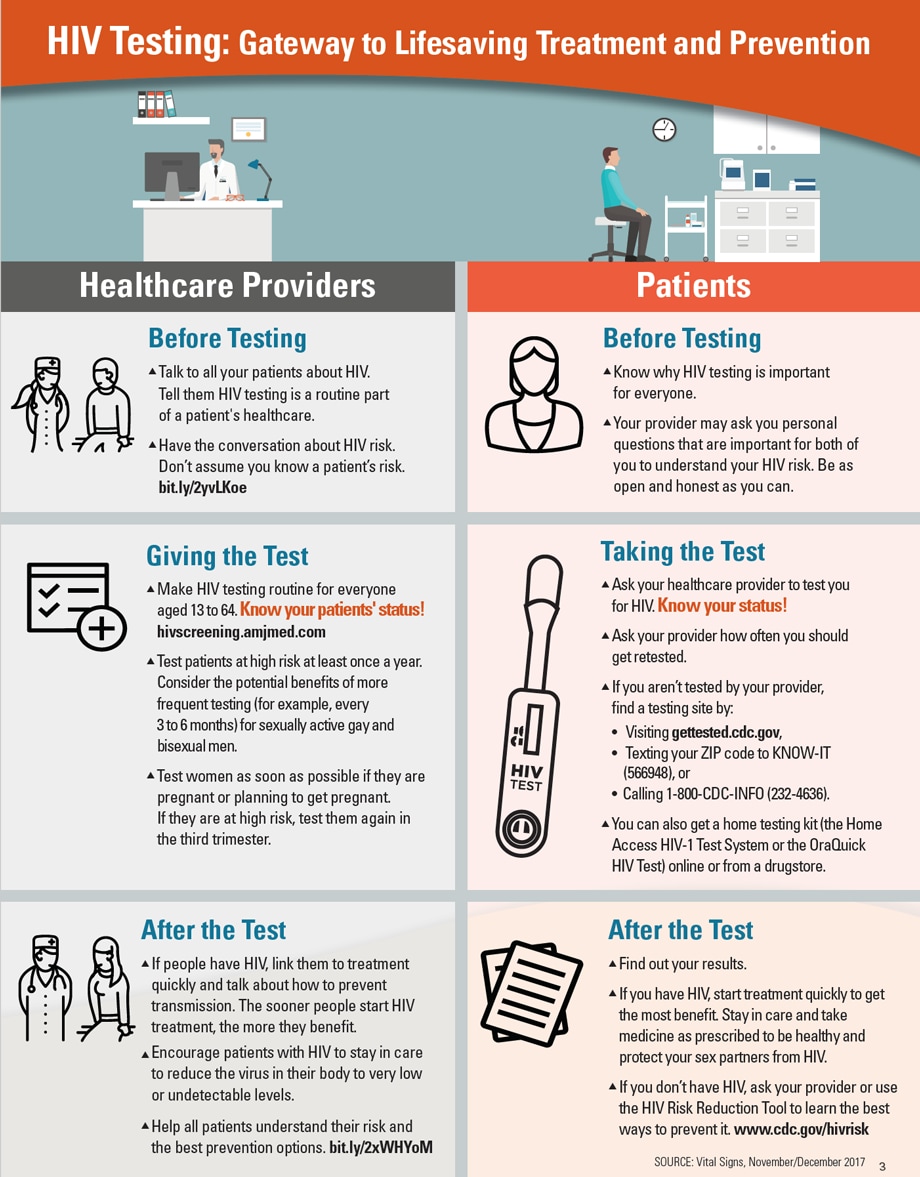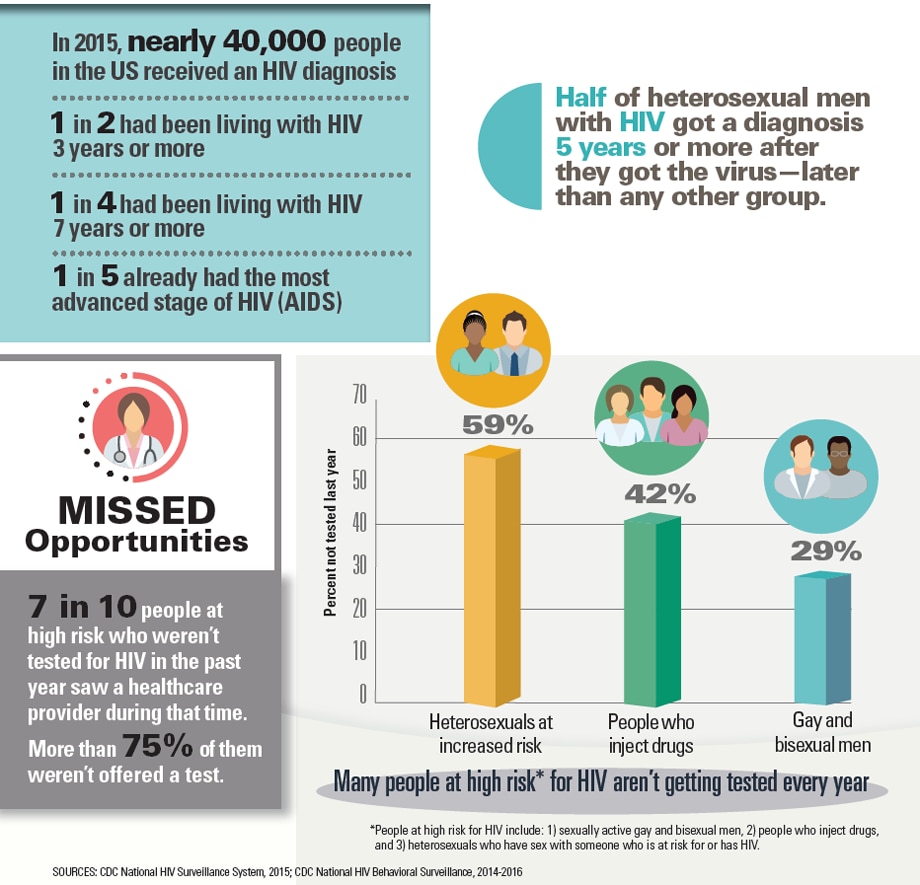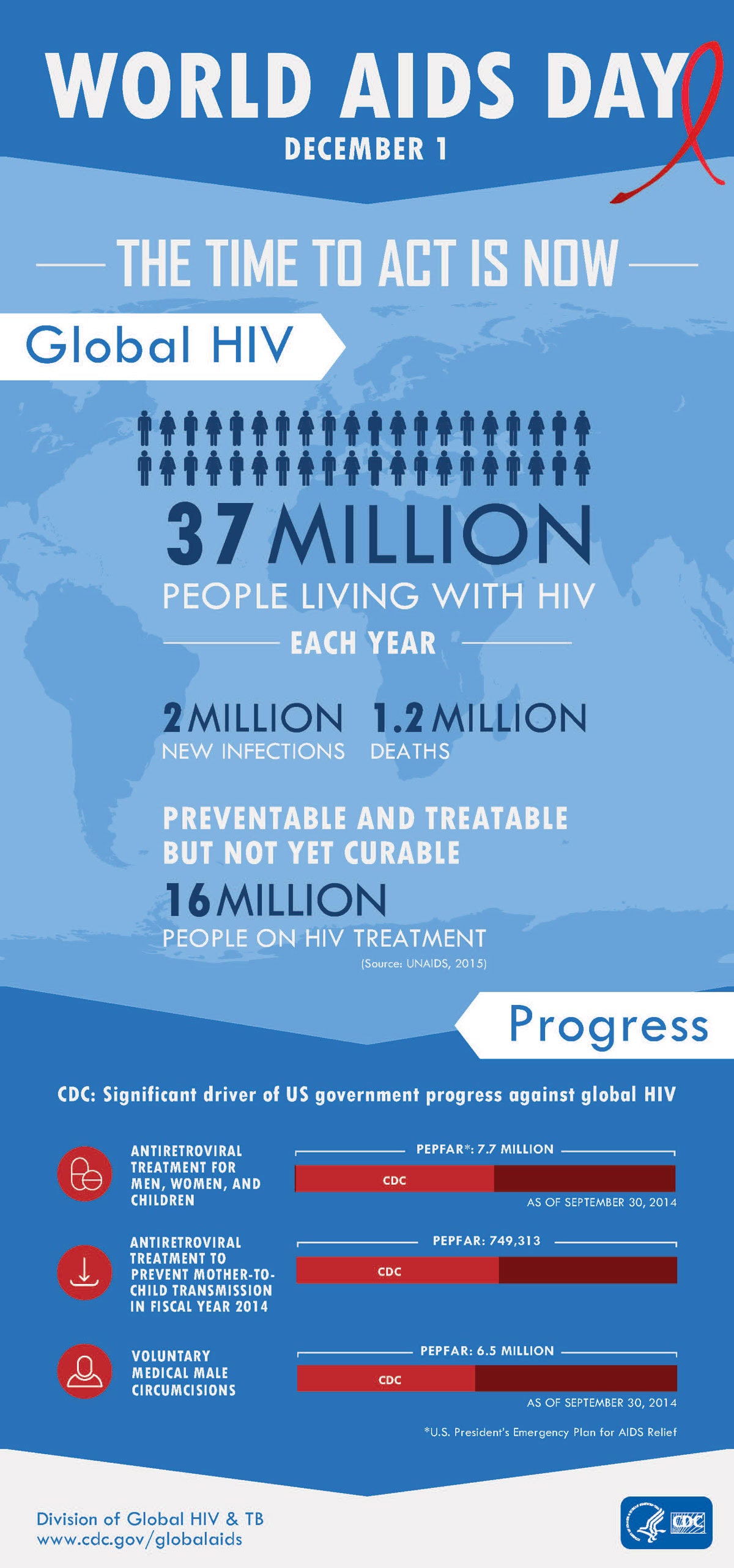Archive for the ‘HIV/AIDS’ Category
HIV, circumcision & Tanzanian members of Parliament
Monday, February 11th, 2019“A female MP in Tanzania has called for checks to determine whether or not her male colleagues have undergone circumcision – a procedure known to reduce the risk of HIV transmission……The World Health Organization (WHO) says circumcision reduces the risk of heterosexual men contracting HIV by around 60%……”
World AIDS Day — December 1, 2018
Saturday, December 1st, 2018World AIDS Day, observed each year on December 1, draws attention to the status of the human immunodeficiency virus/acquired immunodeficiency syndrome (HIV/AIDS) epidemic worldwide. Today, approximately 36.9 million persons worldwide are living with HIV infection, including 1.8 million persons newly infected during 2017 (1). An estimated 940,000 persons worldwide died from AIDS-related illnesses in 2017 (1).
In 2015, an estimated 1.1 million persons in the United States were living with HIV infection, and 86% were aware of their infection (2).
Through global efforts, including the U.S. President’s Emergency Plan for AIDS Relief, for which CDC is an implementing agency, 21.7 million persons worldwide received antiretroviral therapy for HIV infection in 2017, an increase of 2.3 million persons since the end of 2016 (1). A report in this issue of MMWR (3) describes activities to implement the Treat All policy in India, which involves offering antiretroviral therapy to all persons with HIV infection.
References
- Joint United Nations Programme on HIV/AIDS. Miles to go. Global AIDS update 2018. Geneva, Switzerland: Joint United Nations Programme on HIV/AIDS; 2018. http://www.unaids.org/sites/default/files/media_asset/miles-to-go_en.pdf
- CDC. Estimated HIV incidence and prevalence in the United States, 2010–2015. HIV surveillance supplemental report 2018, vol. 23, no. 1. Atlanta, GA: US Department of Health and Human Services, CDC; 2018. https://www.cdc.gov/hiv/pdf/library/reports/surveillance/cdc-hiv-surveillance-supplemental-report-vol-23-1.pdf
- Mitruka K, Bamrotiya M, Agarwal R, et al. Implementation of the Treat All policy among persons living with HIV infection enrolled in care but not on antiretroviral therapy—India, May 2017–June 2018. MMWR Morb Mortal Wkly Rep 2018;67:1305–9.
Suggested citation for this article: World AIDS Day — December 1, 2018. MMWR Morb Mortal Wkly Rep 2018;67:1305. DOI: http://dx.doi.org/10.15585/mmwr.mm6747a1.
The Plight of HIV-AIDS’ Victims: Venezuela’s economy has crumbled, causing crippling shortages of medicine and diagnostic tests
Wednesday, May 9th, 2018“…….In recent years, amid profound shortages of medicine coupled with widespread ignorance, H.I.V. has spread rapidly throughout the Orinoco Delta and is believed to have killed hundreds of the Warao indigenous people …..”
World AIDS Day — December 1, 2017
Friday, December 1st, 2017World AIDS Day, observed each year on December 1, draws attention to the status of the human immunodeficiency virus/acquired immunodeficiency syndrome (HIV/AIDS) epidemic worldwide. The first cases of AIDS were reported in the June 5, 1981, issue of MMWR (1). Today, approximately 36.7 million persons worldwide are living with HIV infection, including approximately 1.8 million persons who were newly infected during 2016 (2). Although the number of annual AIDS-related deaths has declined 48% since 2005, an estimated 1 million persons worldwide died from AIDS in 2016 (2).
In the United States, approximately 39,800 persons received a diagnosis of HIV infection in 2016 (3). In 2014, an estimated 1.1 million persons in the United States were living with HIV infection, and 85% were aware of their infection (4).
Global efforts, including the U.S. President’s Emergency Plan for AIDS Relief, for which CDC is an important implementing agency, resulted in 19.5 million persons worldwide receiving antiretroviral therapy for HIV infection in 2016, an increase from 17.1 million in 2015 (5).
References
- CDC. Pneumocystis pneumonia—Los Angeles. MMWR Morb Mortal Wkly Rep 1981;30:250–2. https://www.cdc.gov/mmwr/preview/mmwrhtml/june_5.htm PubMed
- Joint United Nations Programme on HIV/AIDS. UNAIDS data 2017. Geneva, Switzerland: Joint United Nations Programme on HIV/AIDS; 2017. http://www.unaids.org/sites/default/files/media_asset/20170720_Data_book_2017_en.pdf
- CDC. Diagnoses of HIV infection in the United States and dependent areas, 2016. HIV surveillance report 2016:28. https://www.cdc.gov/hiv/library/reports/hiv-surveillance.html
- CDC. Monitoring selected national HIV prevention and care objectives by using HIV surveillance data—United States and 6 dependent areas, 2015. HIV surveillance supplemental report 2017:22(2). https://www.cdc.gov/hiv/pdf/library/reports/surveillance/cdc-hiv-surveillance-supplemental-report-vol-22-2.pdf
- Joint United Nations Programme on HIV/AIDS. Ending AIDS progress towards the 90–90–90 targets. Global AIDS update, 2017. Geneva, Switzerland: Joint United Nations Programme on HIV/AIDS; 2017. http://www.unaids.org/sites/default/files/media_asset/Global_AIDS_update_2017_en.pdf
Suggested citation for this article: World AIDS Day — December 1, 2017. MMWR Morb Mortal Wkly Rep 2017;66:1285. DOI: http://dx.doi.org/10.15585/mmwr.mm6647a1.
HIV/AIDS: About 40% of new HIV infections come from people who don’t know they have HIV.
Friday, December 1st, 2017
HIV/AIDS: 1 in 2 people with HIV have had the virus at least 3 years before diagnosis.
Friday, December 1st, 2017
** Vaginal ring provides partial protection from HIV
Tuesday, February 23rd, 2016Monday, February 22, 2016
Vaginal ring provides partial protection from HIV in large multinational trial
NIH-funded study finds protective effect strongest in women over age 25.

A ring that continuously releases an experimental antiretroviral drug in the vagina safely provided a modest level of protection against HIV infection in women, a large clinical trial in four sub-Saharan African countries has found. The ring reduced the risk of HIV infection by 27 percent in the study population overall and by 61 percent among women ages 25 years and older, who used the ring most consistently.
These results were announced today at the Conference on Retroviruses and Opportunistic Infections (CROI) in Boston and simultaneously published online in the New England Journal of Medicine (link is external).
“Women need a discreet, long-acting form of HIV prevention that they control and want to use,” said Anthony S. Fauci, M.D., director of the National Institute of Allergy and Infectious Diseases (NIAID), part of the National Institutes of Health (NIH) and the primary funder of the trial. “This study found that a vaginal ring containing a sustained-release antiretroviral drug confers partial protection against HIV among women in sub-Saharan Africa. Further research is needed to understand the age-related disparities in the observed level of protection.”
Women accounted for more than half of the 25.8 million people living with HIV in sub-Saharan Africa in 2014. Finding effective HIV prevention tools for adolescent girls and young women in particular is critical, as one in four new HIV infections in sub-Saharan Africa occur in this group.
The ASPIRE study, also known as MTN-020, aimed to determine whether the experimental antiretroviral drug dapivirine could safely and effectively prevent HIV infection when continuously released in the vagina from a silicone ring replaced once every 4 weeks. The study, which began in 2012, enrolled more than 2,600 HIV-uninfected women ages 18 to 45 years who were at high risk for HIV infection at 15 sites in Malawi, South Africa, Uganda and Zimbabwe. The women were assigned at random to receive either the dapivirine ring or a placebo ring. No one knew who received which ring until the end of the trial.
All study participants received a package of HIV prevention services at each study visit, including HIV risk-reduction counseling, partner HIV testing, treatment of sexually transmitted infections in participants and their partners, and free condoms.
The investigators found that the dapivirine ring reduced the risk of acquiring HIV by 27 percent among all women enrolled in the trial. But when the scientists excluded data from two sites where it was apparent early on that many women were not returning for study visits or using the ring consistently, the ring reduced the risk of HIV infection by 37 percent.
Furthermore, the investigators found that the dapivirine ring reduced the risk of HIV infection by 61 percent in women ages 25 and older, but provided no statistically significant protection in women younger than 25 years. These younger women appeared to use the ring less consistently than other participants, based on the amount of dapivirine measured in volunteers’ blood during study visits.
To explore this age-related effect further, investigators performed analyses that were not originally planned and found that the ring reduced the risk of HIV infection by 56 percent in women older than 21 years, but provided no protection for women ages 18 to 21 years. More research is needed to determine whether behavior, biology or a combination of factors contributed to the lack of significant protection for younger women.
Finally, the investigators found that the rate of adverse medical events was similar among women who received the dapivirine ring compared to those who received the placebo ring, as was the frequency of antiretroviral resistance in women who acquired HIV.
“To help bring about an end to the HIV/AIDS epidemic, women — especially those in sub-Saharan Africa — need multiple options for HIV prevention,” said Jared Baeten, M.D., Ph.D., who co-led the study for the NIH-funded Microbicide Trials Network (MTN). “The ASPIRE study was an important step towards determining whether the dapivirine ring could become one such option.” Dr. Baeten is a professor of global health, medicine and epidemiology at the University of Washington in Seattle.
“The ASPIRE study is the first to demonstrate that a sustained drug delivery product that slowly releases an antiretroviral drug over time can offer partial protection from HIV,” added Thesla Palanee-Phillips, Ph.D., who led the study with Dr. Baeten. Dr. Palanee-Phillips is the director of network trials and research center programs at the Wits Reproductive Health and HIV Institute in Johannesburg, South Africa.
An ongoing large multinational clinical trial called The Ring Study also tested the dapivirine ring for safety and efficacy in women. Similar to ASPIRE, The Ring Study investigators found an overall effectiveness of 31 percent, with a slightly greater reduction in risk of HIV infection among women older than 21 years. The results of The Ring Study also were announced today at CROI.
NIAID plans to consult with a panel of outside experts to determine next steps for research on the dapivirine ring, which the International Partnership for Microbicides (IPM) developed and provided for both studies as their regulatory sponsor.
The ASPIRE study was funded by NIAID, the Eunice Kennedy Shriver National Institute of Child Health and Human Development and the National Institute of Mental Health, all part of NIH, and conducted by MTN.
The Ring Study is being funded by the Bill and Melinda Gates Foundation, the U.S. President’s Emergency Plan for AIDS Relief, the U.S. Agency for International Development, and several European governments and organizations, and is being conducted by IPM.
For more information about the ASPIRE study, please see Questions and Answers: The ASPIRE HIV Prevention Study, ClinicalTrials.gov using study identifier NCT01617096 (link is external). For more information about The Ring Study, please see the IPM press release (link is external).
NIAID conducts and supports research — at NIH, throughout the United States, and worldwide — to study the causes of infectious and immune-mediated diseases, and to develop better means of preventing, diagnosing and treating these illnesses. News releases, fact sheets and other NIAID-related materials are available on the NIAID website.
About the National Institutes of Health (NIH): NIH, the nation’s medical research agency, includes 27 Institutes and Centers and is a component of the U.S. Department of Health and Human Services. NIH is the primary federal agency conducting and supporting basic, clinical, and translational medical research, and is investigating the causes, treatments, and cures for both common and rare diseases. For more information about NIH and its programs, visit www.nih.gov.
NIH…Turning Discovery Into Health®
UNICEF: The number of adolescent deaths from AIDS has tripled over the last 15 years
Sunday, November 29th, 2015The data reveal that currently among adolescents (15-19):
- 26 new infections occur every hour; and
- About half of those living with HIV are in just six countries:
- South Africa
- Nigeria
- Kenya
- India
- Mozambique
- Tanzania.
UNICEF’s Statistical Update on Children, Adolescents and AIDS report can be downloaded here: www.childrenandaids.org



